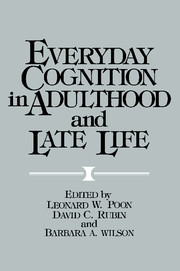Book contents
- Frontmatter
- Contents
- List of contributors
- Preface
- Part I Adult cognitive abilities in the laboratory and in real-life settings: Basic theoretical and methodological issues
- Part IA Systematic approaches to laboratory and real-world research
- Part IB Combining laboratory and real-world research
- 6 The laboratory and ecology: Supplementary sources of data for memory research
- 7 Issues of regularity and control: Confessions of a regularity freak
- 8 Finding the bloody horse
- 9 Some bad and some good reasons for studying memory and cognition in the wild
- Part II Cognition in adulthood and late life: Findings in real-life settings
- Part IIA Everyday cognitive abilities
- Part IIB Concomitant influences
- Part III Cognitive enhancement and aging: Clinical and educational applications
- Part IIIA Issues and perspectives
- Part IIIB Enhancement approaches
- Part IIIC Designing programs for cognitive rehabilitation
- Subject index
- Author index
6 - The laboratory and ecology: Supplementary sources of data for memory research
Published online by Cambridge University Press: 05 October 2013
- Frontmatter
- Contents
- List of contributors
- Preface
- Part I Adult cognitive abilities in the laboratory and in real-life settings: Basic theoretical and methodological issues
- Part IA Systematic approaches to laboratory and real-world research
- Part IB Combining laboratory and real-world research
- 6 The laboratory and ecology: Supplementary sources of data for memory research
- 7 Issues of regularity and control: Confessions of a regularity freak
- 8 Finding the bloody horse
- 9 Some bad and some good reasons for studying memory and cognition in the wild
- Part II Cognition in adulthood and late life: Findings in real-life settings
- Part IIA Everyday cognitive abilities
- Part IIB Concomitant influences
- Part III Cognitive enhancement and aging: Clinical and educational applications
- Part IIIA Issues and perspectives
- Part IIIB Enhancement approaches
- Part IIIC Designing programs for cognitive rehabilitation
- Subject index
- Author index
Summary
Nonexperimental methods have a well-accepted place among the research strategies employed by psychologists. Such methods have long been part of the standard content of textbooks dealing with research methodology (Elmes, Kantowitz, & Roediger, 1985; Festinger & Katz, 1953). In certain areas of the field (e.g., the psychology of personality or abnormal psychology), naturalistic investigations predominate. In other areas (e.g., perception, learning, and memory), the laboratory approach has been preeminent.
Historical perspective
Experimental methods were introduced into psychology during the 19th century, when it was first demonstrated that some psychological questions would yield to a laboratory attack. The success of these first efforts promoted the acceptance of psychology as a science and gave rise to the term “experimental psychology.” Although the meaning of that term has changed somewhat during the last 100 years (Danziger, 1985), the emphasis on the laboratory as a place for empirical explorations has remained and has promoted the scientific status of psychology. Exclusive organizations and journals (e.g., the Society of Experimental Psychologists and the Journal of Experimental Psychology) helped to establish traditions and define a separate, elitist image for laboratory research and for psychologists who used experimental methods. Memory research has been dominated by these traditions for most of the past century. However, demands for ecological validity have challenged these traditions from time to time, and the challenges have been particularly effective during the last decade.
Information
- Type
- Chapter
- Information
- Everyday Cognition in Adulthood and Late Life , pp. 73 - 83Publisher: Cambridge University PressPrint publication year: 1989
Accessibility standard: Unknown
Why this information is here
This section outlines the accessibility features of this content - including support for screen readers, full keyboard navigation and high-contrast display options. This may not be relevant for you.Accessibility Information
- 4
- Cited by
